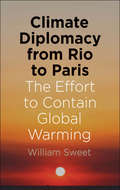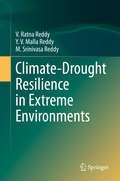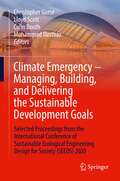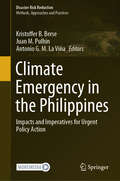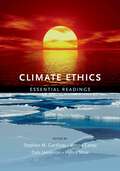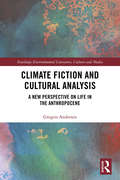- Table View
- List View
Climate Diplomacy from Rio to Paris: The Effort to Contain Global Warming
by William SweetThe essential primer for understanding climate diplomacy, describing both the major players and the path to progress, from the 1992 Rio Summit to the 2015 Paris Climate Conference Climate Diplomacy from Rio to Paris is the first accessible overview of climate diplomacy in its first quarter century. The author, who has reported on energy and climate for two decades, provides readers with a nuanced account of the major players and their interests—from the United States, the European Union, and China to environmental organizations, the United Nations, and the Vatican—and analyzes the outcomes of the major climate conferences at Rio, Kyoto, Copenhagen, and Paris.
Climate Displacement in Mexico: Towards Vulnerable Population Protection
by Armelle GouritinThis book presents the updated results of an investigation carried out in 2019. The National Autonomous University of Mexico’s (UNAM) Climate Change Research Program (PINCC), funded the research coordinated by Armelle Gouritin. The research aims to answer the following questions: Does the Mexican legal framework and public policies address forced internal climate mobility? If not, what could be the elements of a legal framework and public policies to address the phenomenon? As the phenomenon was approached it was clear that it was extremely complex and consisted of numerous tensions that would lead to other questions throughout the research process.Climate forced internal displacement is projected as a huge-scale phenomenon in Mexico. Against this background, the book provides the first critical diagnosis of the current politico-legal Mexican framework and finds it to be lagging behind in terms of prevention and attention. The book analyses the three-level Mexican governance (federal, state and local levels), and identifies serious loopholes according to a rights-based approach that particularly focuses on women, indigenous peoples, and persons and communities with scarce economic resources. The results provide information on up-coming legislative and political processes and provide benchmarks that can be applied in other case-studies, including other national frameworks’ critical analysis.
Climate Driven Retreat of Mount Baker Glaciers and Changing Water Resources (SpringerBriefs in Climate Studies)
by Mauri PeltoThis book presents the impact of climate change on Mount Baker glaciers, USA, and the rivers surrounding them. Glaciers are natural reservoirs that yield their resource primarily on warm dry summer days when other sources are at their lowest yield. This natural tempering of drought conditions will be reduced as they retreat. Mount Baker, a volcano in the Cascades of Washington, is currently host to 12 principal glaciers with an area of 36.8 km2. The glaciers yield 125 million cubic meters of water each summer that is a resource for salmon, irrigation and hydropower to the Nooksack River and Baker River watersheds. Recent rapid retreat of all 22 glaciers is altering the runoff from the glaciers, impacting both the discharge and temperature of the Nooksack and Baker River. Over the last 30 years we have spent 270 nights camped on the mountain conducting 10,500 observations of snow depth and melt rate on Mount Baker. This data combined with observations of terminus change, area change and glacier runoff over the same 30 years allow an unusually comprehensive story to be told of the effects of climate change to Mount Baker Glaciers and the rivers that drain them.
Climate-Drought Resilience in Extreme Environments
by V. Ratna Reddy Y. V. Reddy M. Srinivasa ReddyThis book assesses the effectiveness of changes in watershed interventions in one of the most fragile resource regions of India. Specifically the chapters examine various watershed centred interventions and their implementation process. An evaluation of the livelihood impacts, including crop production on the communities, is discussed and an assessment of the drought and climate resilience of households in the context of watershed and related interventions, including institutions and capacity of the communities, is investigated. Lessons are drawn to further identify measures to strengthen and improvise interventions for enhanced climate-drought resilience in harsh environments.
Climate Dynamics
by Kerry H. CookA concise introduction to climate system dynamicsClimate Dynamics is an advanced undergraduate-level textbook that provides an essential foundation in the physical understanding of the earth's climate system. The book assumes no background in atmospheric or ocean sciences and is appropriate for any science or engineering student who has completed two semesters of calculus and one semester of calculus-based physics.Describing the climate system based on observations of the mean climate state and its variability, the first section of the book introduces the vocabulary of the field, the dependent variables that characterize the climate system, and the typical approaches taken to display these variables. The second section of the book gives a quantitative understanding of the processes that determine the climate state—radiation, heat balances, and the basics of fluid dynamics. Applications for the atmosphere, ocean, and hydrological cycle are developed in the next section, and the last three chapters of the book directly address global climate change. Throughout, the textbook makes connections between mathematics and physics in order to illustrate the usefulness of mathematics, particularly first-year calculus, for predicting changes in the physical world.Climate change will impact every aspect of life in the coming decades. This book supports and broadens understanding of the dynamics of the climate system by offering a much-needed introduction that is accessible to any science, math, or engineering student.Makes a physically based, quantitative understanding of climate change accessible to all science, engineering, and mathematics undergraduatesExplains how the climate system works and why the climate is changingReinforces, applies, and connects the basic ideas of calculus and physicsEmphasizes fundamental observations and understandingAn online illustration package and solutions manual for professors is available
Climate Dynamics: Why Does Climate Vary? (Geophysical Monograph Series #189)
by De-Zheng Sun Frank BryanPublished by the American Geophysical Union as part of the Geophysical Monograph Series, Volume 189. Climate Dynamics: Why Does Climate Vary? presents the major climate phenomena within the climate system to underscore the potency of dynamics in giving rise to climate change and variability. These phenomena include deep convection over the Indo-Pacific warm pool and its planetary-scale organization: the Madden-Julian Oscillation, the monsoons, the El Niño-Southern Oscillation, the Pacific Decadal Oscillation, and the low-frequency variability of extratropical circulations. The volume also has a chapter focusing on the discussion of the causes of the recent melting of Arctic sea ice and a chapter devoted to the discussion of the causes of recent changes in the frequency and intensity of tropical cyclones. On each topic, the basic material of climate dynamics is covered to aid the understanding of the forefront research, making the volume accessible to a broad spectrum of readers. The volume highlights include Diabatic and nonlinear aspects of the El Niño-Southern Oscillation Causes of sea ice melting in the Arctic Impact of global warming on tropical cyclone activity Origins of the Pacific Decadal Oscillation Causes of climate variability of Asian monsoons The volume will be of particular interest to graduate students and young researchers in atmospheric and oceanic sciences and related disciplines such as geology and geography. The book will also be a good read for those who have a more general interest in the Earth's climate and why it varies.
Climate Dynamics: Why Does Climate Vary? (Geophysical Monograph Series #189)
by De-Zheng Sun Frank BryanPublished by the American Geophysical Union as part of the Geophysical Monograph Series, Volume 189. Climate Dynamics: Why Does Climate Vary? presents the major climate phenomena within the climate system to underscore the potency of dynamics in giving rise to climate change and variability. These phenomena include deep convection over the Indo-Pacific warm pool and its planetary-scale organization: the Madden-Julian Oscillation, the monsoons, the El Niño-Southern Oscillation, the Pacific Decadal Oscillation, and the low-frequency variability of extratropical circulations. The volume also has a chapter focusing on the discussion of the causes of the recent melting of Arctic sea ice and a chapter devoted to the discussion of the causes of recent changes in the frequency and intensity of tropical cyclones. On each topic, the basic material of climate dynamics is covered to aid the understanding of the forefront research, making the volume accessible to a broad spectrum of readers. The volume highlights include Diabatic and nonlinear aspects of the El Niño-Southern Oscillation Causes of sea ice melting in the Arctic Impact of global warming on tropical cyclone activity Origins of the Pacific Decadal Oscillation Causes of climate variability of Asian monsoons The volume will be of particular interest to graduate students and young researchers in atmospheric and oceanic sciences and related disciplines such as geology and geography. The book will also be a good read for those who have a more general interest in the Earth's climate and why it varies.
Climate Dynamics of the Tropics (Atmospheric and Oceanographic Sciences Library #8)
by S. HastenrathThe first edition of my book "Climate and Circulation of the Tropics" was reasonably up to date to the middle of 1985. In a second printing in 1988 it was possible to complete a few literature references and to correct some misprints. However, vigorous research has taken place over the past five years in various areas of tropical climate dynamics, especially in the atmosphere-ocean mechanisms of climate anomalies, climate prediction, ocean circulation, and paleoclimates. Promising progress has also been made in the application of general circulation modelling to tropical climate problems. In the present second edition, named "Climate Dynamics of the Tropics", I have attempted to incorporate much of the recent work to late 1990. Chapters 8 and 9 have been essentially re-written, and major additions have been made to Chapters 4 and 12 in particular. I would like to acknowledge the continued support by the U.S. National Science Foundation over the past five years. B. Parthasarathy, Poona, and H. Lessmann, San Salvador, sent me updates of data series not easily accessible. I have benefitted from discussions with numerous colleagues in the United States and overseas. In the preparation of this second edition, Marilyn Wolff patiently transferred my illegible hand-written drafts onto word processor. Dierk Polzin and Dan Skemp assisted me with the creation of the page masters and the subject index and Christopher Collimore with the author index.
Climate Dynamics (PDF)
by Kerry H. CookClimate Dynamics is an advanced undergraduate-level textbook that provides an essential foundation in the physical understanding of the earth's climate system. The book assumes no background in atmospheric or ocean sciences and is appropriate for any science or engineering student who has completed two semesters of calculus and one semester of calculus-based physics. Describing the climate system based on observations of the mean climate state and its variability, the first section of the book introduces the vocabulary of the field, the dependent variables that characterize the climate system, and the typical approaches taken to display these variables. The second section of the book gives a quantitative understanding of the processes that determine the climate state--radiation, heat balances, and the basics of fluid dynamics. Applications for the atmosphere, ocean, and hydrological cycle are developed in the next section, and the last three chapters of the book directly address global climate change. Throughout, the textbook makes connections between mathematics and physics in order to illustrate the usefulness of mathematics, particularly first-year calculus, for predicting changes in the physical world. Climate change will impact every aspect of life in the coming decades. This book supports and broadens understanding of the dynamics of the climate system by offering a much-needed introduction that is accessible to any science, math, or engineering student. Makes a physically based, quantitative understanding of climate change accessible to all science, engineering, and mathematics undergraduates Explains how the climate system works and why the climate is changing Reinforces, applies, and connects the basic ideas of calculus and physics Emphasizes fundamental observations and understanding An online illustration package and solutions manual for professors is available
Climate, Earth Processes and Earth History
by Richard J. HuggettToday, climate-related processes and problems are referred to as Global Change by nearly everyone including scientists, politicians, and economists; citizens worldwide are anxious about the often ob served disorientation of our environment under the influence of man. Better information on the Earth's natural systems and their possible alterations is necessary. The topic itself is so wide that sound scien tific descriptions of it as a whole are rare. For the non-specialist infor mation from relevant fields is not easy to obtain; and often, the pro gnostic models presented are contradictory and even for specialists difficult to evaluate. Therefore, this book on Climate, Earth Processes and Earth History by Richard Huggett fills an important gap. It discusses the great, climate-related areas of the Earth's environment. The atmosphere, the hydrosphere, the sediments as products of weathering and geomorphic processes, the relief as landforms and soils, and the biosphere are thoroughly treated as the prominent sub systems which are greatly affected by climate. These subsystems not only control the visual and internal aspects of our landscapes, but they are themselves especially influenced by climatic changes which can be due to either changes in the natural system or anthropogenic changes. Thus, our landscapes will be subject to significant altera tions, if climatic variations exceed certain thresholds. The plan for the present book by Richard Huggett was originally discussed in regard to the Springer Series on Physical Environment.
Climate Economics: Economic Analysis of Climate, Climate Change and Climate Policy, Second Edition (Routledge Explorations In Environmental Economics Ser.)
by Richard S.J. TolThis unique textbook offers comprehensive coverage of the economics of climate change and climate policy, and is a suitable guide for advanced undergraduate, post-graduate, and doctoral students. Topics discussed include the costs and benefits of adaptation and mitigation, discounting, uncertainty, policy instruments, and international agreements. Key features of the second edition: • In-depth treatment of the economics of climate change • careful explanations of concepts and their application to climate policy • customizable integrated assessment model that illustrates all issues discussed • specific usage guidelines for each level of reader • companion website featuring data, extra reading, quizzes, videos, and more to support seminar sessions and further exploration of the topic • discussion of the latest developments in theory and policy • a stronger empirical basis than the first edition. This book is an essential text for advanced undergraduate and masters students in economics, climate change, and environmental policy, and an excellent resource for researchers and practitioners looking for a key text to support them across all of their teaching.
Climate Economics: Economic Analysis of Climate, Climate Change and Climate Policy
by Richard S.J. TolThis thoroughly revised third edition offers comprehensive coverage of the economics of climate change and climate policy, and is a suitable guide for advanced undergraduate, postgraduate, and doctoral students. Topics discussed include the costs and benefits of adaptation and mitigation, discounting, uncertainty, equity, policy instruments, the second best, and international agreements.Key features:In-depth treatment of the economics of climate changeCareful explanation of concepts and their application to climate policyCustomizable integrated assessment model that illustrates all issues discussedSpecific usage guidelines for each level of readerCompanion website with data, quizzes, videos, and further readingDiscussion of the latest developments in theory and policyGreater attention to policy and market imperfections than in the second edition.This book is an essential text for students in economics, climate change, and environmental policy, an excellent resource for researchers and practitioners, and a key text to support professors in their teaching.
Climate Emergency – Managing, Building , and Delivering the Sustainable Development Goals: Selected Proceedings from the International Conference of Sustainable Ecological Engineering Design for Society (SEEDS) 2020
by Christopher Gorse Lloyd Scott Colin Booth Mohammad DastbazThrough research and proven practice, the aim of the International Conference of Sustainable Ecological Engineering Design for Society (SEEDS) is to foster ideas on how to reduce negative impacts on the environment while providing for the health and well-being of society. The professions and fields of research required to ensure buildings meet user demands and provide healthy enclosures are many and diverse. The SEEDS conference addresses the interdependence of people, the built and natural environments, and recognizes the interdisciplinary and international themes necessary to assemble the knowledge required for positive change.
Climate Emergency in the Philippines: Impacts and Imperatives for Urgent Policy Action (Disaster Risk Reduction)
by Kristoffer B. Berse Juan M. Pulhin Antonio G. M. La ViñaThis book provides a snapshot of the manifestations of the climate emergency in the Philippines from a wide array of disciplines including physical sciences, social sciences, arts and humanities, management, and law. Researchers and faculties at the University of the Philippines contributed to this compilation, where each chapter provides policymakers and the public a clear picture of why climate change must be confronted with a sense of urgency and near-desperation.Divided into three main parts, the first one zeroes in on climate-vulnerable sectors such as water, food and agriculture, health, and coastal communities in the Philippines to introduce readers to the current pressing impacts of the climate emergency. The second part presents case studies of local experiences from the country’s three island regions, namely, Luzon, Visayas, and Mindanao, and it situates the readers in different environments and contexts. The third part features transdisciplinary responses to the climate emergency, including salient challenges in relation to planning, financing, communication, and education. The concluding chapter highlights eight areas for action to tackle the climate emergency. Each chapter comes with an overview and a Summary for Policymakers, which provides clear guidance for action to be taken by both local and national policymakers.
Climate Engineering: Möglichkeiten und Risiken (essentials)
by Wolfgang OsterhageUnter der Prämisse, dass ein Klimawandel stattfindet, arbeitet Wolfgang Osterhage eine Problemstellung heraus, die zu Lösungsvorschlägen im Rahmen des Climate Engineering führt, mit welchen das Klima pro-aktiv beeinflusst werden kann. Der Autor stellt die hierfür erforderlichen technischen Maßnahmen vor. In die Bewertung von Risiken fließen thermodynamische und chaostheoretische Überlegungen ein, die zu einer kritischen Beurteilung führen. Weitere Bewertungskriterien ergeben sich schließlich aus ethischen Grundsatzüberlegungen.
Climate, Environment and Cree Observations: James Bay Territory, Canada (SpringerBriefs in Climate Studies)
by Marie-Jeanne S. RoyerThis book examines the effects of climate and environmental change in the Eastern James Bay, Canada. This socio-environmentally oriented volume integrates scientific literature with the established ecological knowledge to explore current issues. This multidisciplinary approach allows for a broader understanding of the forces at play on the environment and the societies that inhabit it. It is suited to a wide range of readers from researchers and professionals working in the field to graduate students in climate change, geography, environmental science and ecology.
Climate, Environment and Disaster in Developing Countries (Advances in Geographical and Environmental Sciences)
by R. B. Singh Narayan Chandra JanaThe world is currently experiencing changes in climate and environment that often lead to natural disasters. Nearly three million people worldwide may have been killed in the past 20 years by natural disasters. In total, 90% of the natural disasters and 95% of all disaster-related deaths occur in the developing countries. Recently such problems have accelerated due to LULC change, biodiversity degradation, increased tourism, urbanization and climate change. This book, consisting of 27 chapters, explores the topics of climate, environment and natural disasters in developing countries. It is essential to discuss these diverse issues in the field of geography as it encompasses interdisciplinary topics. The range of issues on national, regional and local dimensions is not only confined to geography but also concerned to other disciplines as well. Therefore, this book is a valuable source for scientists and researchers in allied fields such as climatology, disaster management, environmental science, hydrology, agriculture, and land use studies, among other areas. Furthermore, this book can be of immense help to the planners and decision-makers engaged in dealing with the problems of climate, environmental change and natural disasters in developing countries.
Climate, Environmental Hazards and Migration in Bangladesh (Routledge Studies in Hazards, Disaster Risk and Climate Change)
by Max MartinThe apocalyptic visions of climate change that are projected in the media often involve extreme weather events, disasters and mass migration of poor people. This book takes a critical look at this notion, drawing on research in Bangladesh, a country located at the heart of debates on climate change and migration. This book argues that rather than leading to dramatic events, climatic and environmental impacts often cause incremental changes in people’s habitats and livelihoods, making them migrate in search of better places and income. With or without climate change, climatic and environmental factors can impoverish people, and drive displacement and migration, especially in the global South. These influences, including disasters, need not necessarily make people move, but instead sometimes trap the poorest and the most vulnerable people in their places exposed to hazards or make them migrate to even riskier places, such as crowded and flood-prone urban slums. This book argues that restrictions placed on people’s mobility options could increase their vulnerability and favours proactive migration policies. This timely contribution explains the climate-hazard-migration nexus in an accessible, engaging language for students of geography, development studies, politics and environmental studies, as well as humanitarian and development practitioners and policymakers.
Climate, Environmental Hazards and Migration in Bangladesh (Routledge Studies in Hazards, Disaster Risk and Climate Change)
by Max MartinThe apocalyptic visions of climate change that are projected in the media often involve extreme weather events, disasters and mass migration of poor people. This book takes a critical look at this notion, drawing on research in Bangladesh, a country located at the heart of debates on climate change and migration. This book argues that rather than leading to dramatic events, climatic and environmental impacts often cause incremental changes in people’s habitats and livelihoods, making them migrate in search of better places and income. With or without climate change, climatic and environmental factors can impoverish people, and drive displacement and migration, especially in the global South. These influences, including disasters, need not necessarily make people move, but instead sometimes trap the poorest and the most vulnerable people in their places exposed to hazards or make them migrate to even riskier places, such as crowded and flood-prone urban slums. This book argues that restrictions placed on people’s mobility options could increase their vulnerability and favours proactive migration policies. This timely contribution explains the climate-hazard-migration nexus in an accessible, engaging language for students of geography, development studies, politics and environmental studies, as well as humanitarian and development practitioners and policymakers.
Climate Ethics: Essential Readings (Environmental Ethics And Science Policy Ser.)
by Stephen M. GardinerThis collection gathers a set of seminal papers from the emerging area of ethics and climate change. Topics covered include human rights, international justice, intergenerational ethics, individual responsibility, climate economics, and the ethics of geoengineering. Climate Ethics is intended to serve as a source book for general reference, and for university courses that include a focus on the human dimensions of climate change. It should be of broad interest to all those concerned with global justice, environmental science and policy, and the future of humanity.
Climate Ethics: Essential Readings
by Rajendra Kumar Pachauri Stephen Gardiner Simon Caney Dale Jamieson Henry ShueThis collection gathers a set of seminal papers from the emerging area of ethics and climate change. Topics covered include human rights, international justice, intergenerational ethics, individual responsibility, climate economics, and the ethics of geoengineering. Climate Ethics is intended to serve as a source book for general reference, and for university courses that include a focus on the human dimensions of climate change. It should be of broad interest to all those concerned with global justice, environmental science and policy, and the future of humanity.
Climate Ethics: Environmental Justice and Climate Change
by Joerg Chet Tremmel Katherine RobinsonClimate change is perhaps the most important issue of our time and yet despite the urgency of the problem, the measures necessary to mitigate it have not been implemented. International cooperation has not been forthcoming and there remains a general reluctance towards any major change of lifestyle. Given the urgency of the problem, why has so little been done? In Climate Ethics Joerg Tremmel and Katherine Robinson identify the reasons behind this crucial paradox and propose a way forward. In the first part of the book the authors provide an accessible account of the basics of climate change. In clear and accessible terms they explain the science behind climate change and demystify the complicated terminology that so often hinders a proper understanding of the subject. They identify the substances that cause climate change, reveal which industries are responsible and which aspects of people's everyday lives have the highest emissions connected with them. They explore the consequences of ignoring climate change and, importantly, analyse the obstacles to addressing the issues.In the second part of the book the authors introduce the concept of climate ethics, and explore its importance at a personal, national and international level. They place it firmly at the centre of any successful resolution of the challenges associated with climate change. They review the classical theories of justice and how they relate to climate change, and they examine the complex ethical and moral questions that need to be addressed if long-term solutions are to be found. What moral responsibility do we have to future generations? How should we share out emission rights? Do we take into account past emissions, allowing those who have historically caused more pollution fewer emissions rights than developing countries? Who is to finance the measures to abate climate? And just what is the fairest approach to the politics of climate change on a global scale? The result is an original and timely engagement with one of the most pressing problems facing us and future generations.
Climate Extremes: Patterns and Mechanisms (Geophysical Monograph Series #226)
by S.?Y. Simon Wang Y. Simon Wang Christopher C. Funk Robert R. GilliesAlthough we are seeing more weather and climate extremes, individual extreme events are very diverse and generalization of trends is difficult. For example, mid-latitude and subtropical climate extremes such as heat waves, hurricanes and droughts have increased, and could have been caused by processes including arctic amplification, jet stream meandering, and tropical expansion. This volume documents various climate extreme events and associated changes that have been analyzed through diagnostics, modeling, and statistical approaches. The identification of patterns and mechanisms can aid the prediction of future extreme events. Volume highlights include: Compilation of processes and mechanisms unique to individual weather and climate extreme events Discussion of climate model performance in terms of simulating high-impact weather and climate extremes Summary of various existing theories, including controversial ones, on how climate extremes will continue to become stronger and more frequent Climate Extremes: Patterns and Mechanisms is a valuable resource for scientists and graduate students in the fields of geophysics, climate physics, natural hazards, and environmental science.Read an interview with the editors to find out more:https://eos.org/editors-vox/how-does-changing-climate-bring-more-extreme-events
Climate Extremes: Patterns and Mechanisms (Geophysical Monograph Series #226)
by S. Y. Simon Wang Jin-Ho Yoon Christopher C. Funk Robert R. GilliesAlthough we are seeing more weather and climate extremes, individual extreme events are very diverse and generalization of trends is difficult. For example, mid-latitude and subtropical climate extremes such as heat waves, hurricanes and droughts have increased, and could have been caused by processes including arctic amplification, jet stream meandering, and tropical expansion. This volume documents various climate extreme events and associated changes that have been analyzed through diagnostics, modeling, and statistical approaches. The identification of patterns and mechanisms can aid the prediction of future extreme events. Volume highlights include: Compilation of processes and mechanisms unique to individual weather and climate extreme events Discussion of climate model performance in terms of simulating high-impact weather and climate extremes Summary of various existing theories, including controversial ones, on how climate extremes will continue to become stronger and more frequent Climate Extremes: Patterns and Mechanisms is a valuable resource for scientists and graduate students in the fields of geophysics, climate physics, natural hazards, and environmental science.Read an interview with the editors to find out more:https://eos.org/editors-vox/how-does-changing-climate-bring-more-extreme-events
Climate Fiction and Cultural Analysis: A new perspective on life in the anthropocene (Routledge Environmental Literature, Culture and Media)
by Gregers AndersenClimate Fiction and Cultural Analysis argues that the popularity of the term "climate fiction" has paradoxically exhausted the term’s descriptive power and that it has developed into a black box containing all kinds of fictions which depict climatic events and has consequently lost its true significance. Aware of the prospect of ecological collapse as well as our apparent inability to avert it, we face geophysical changes of drastic proportions that severely challenge our ability to imagine the consequences. This book argues that this crisis of imagination can be partly relieved by climate fiction, which may help us comprehend the potential impact of the crisis we are facing. Strictly assigning "climate fiction" to fictions that incorporate the climatological paradigm of anthropogenic global warming into their plots, this book sets out to salvage the term’s speculative quality. It argues that climate fiction should be regarded as no less than a vital supplement to climate science, because climate fiction makes visible and conceivable future modes of existence within worlds not only deemed likely by science, but which are scientifically anticipated. Focusing primarily on English and German language fictions, Climate Fiction and Cultural Analysis shows how Western climate fiction sketches various affective and cognitive relations to the world in its utilization of a small number of recurring imaginaries, or imagination forms. This book will be of great interest to students and scholars of ecocriticism, the environmental humanities, and literary and culture studies more generally.
